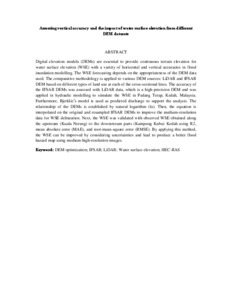Citation
Mokhtar, Ernieza Suhana and Pradhan, Biswajeet and Ghazali, Abdul Halim and Mohd Shafri, Helmi Zulhaidi
(2017)
Assessing vertical accuracy and the impact of water surface elevation from different DEM datasets.
In: Global Civil Engineering Conference (GCEC 2017), 25-28 July 2017, Kuala Lumpur, Malaysia. (pp. 849-862).
Abstract
Digital elevation models (DEMs) are essential to provide continuous terrain elevation for water surface elevation (WSE) with a variety of horizontal and vertical accuracies in flood inundation modelling. The WSE forecasting depends on the appropriateness of the DEM data used. The comparative methodology is applied to various DEM sources: LiDAR and IFSAR DEM based on different types of land use at each of the cross-sectional lines. The accuracy of the IFSAR DEMs was assessed with LiDAR data, which is a high-precision DEM and was applied in hydraulic modelling to simulate the WSE in Padang Terap, Kedah, Malaysia. Furthermore, Bjerklie’s model is used as predicted discharge to support the analysis. The relationship of the DEMs is established by natural logarithm (ln). Then, the equation is interpolated on the original and resampled IFSAR DEMs to improve the medium-resolution data for WSE delineation. Next, the WSE was validated with observed WSE obtained along the upstream (Kuala Nerang) to the downstream parts (Kampung Kubu) Kedah using R2, mean absolute error (MAE), and root-mean-square error (RMSE). By applying this method, the WSE can be improved by considering uncertainties and lead to produce a better flood hazard map using medium-high-resolution images.
Download File
![[img]](http://psasir.upm.edu.my/64620/1.hassmallThumbnailVersion/Assessing%20vertical%20accuracy%20and%20the%20impact%20of%20water%20surface%20elevation%20from%20different%20DEM%20datasets.pdf)  Preview |
|
Text (Abstract)
Assessing vertical accuracy and the impact of water surface elevation from different DEM datasets.pdf
Download (50kB)
| Preview
|
|
Additional Metadata
Actions (login required)
 |
View Item |

